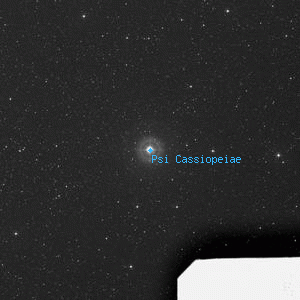Psi Cassiopeiae

Overlaid DSS image of Psi Cassiopeiae, 60' x 60' with north at top and west to the right
Aladin viewer for the region around Psi Cassiopeiae
ψ Cas, 36 Cas
Σ 117, BD+67 123, HD 8491, HR 399, WDS J01259+6808A, SAO 11751, GSC 04297-01685, HIP 6692
Σ 117, BD+67 123, HD 8491, HR 399, WDS J01259+6808A, SAO 11751, GSC 04297-01685, HIP 6692
| Type | Star |
|---|---|
| Magnitude | 4.727 | Right Ascension | 1h 25' 56.0" (2000) |
| Declination | 68° 7' 48" N |
| Constellation | Cassiopeia |
| Classification | K0III-IIIbCN0.5 |
Observing Notes
Andrew Cooper
Dec 1, 2021 Waikoloa, HI (map)
20cm f/6 Newtonian, Cave Astrola @ 76x
Seeing: 7 Transparency: 5 Moon: 0%
Pale orange, an easily visible 9th magnitude companion 20" southeast
Captain William Henry Smyth
Apr 12, 1836 No. 6 The Crescent, Bedford, England (map)
150mm f/17.6 refractor by Tully 1827
A fine triple star, close to the lower part of the Lady's throne, and in a line between Polaris and δ Cassiopeae, at rather less than a third of the distance from the latter. A 4½, orange tint; B 9, blue; C 11, reddish. This object was first seen triple by Σ., and forms No. 117 of his grand Catalogue, where it shows:Pos. AB 101°77 Dist. 32".22 Ep. 1831.04The two first formed H V 83, and were thus measured by him:
BC 253°32 3".01Pos. 102°12' Dist. 33".41 Ep. 1782.66H. and S., who overlooked C, found AB =Pos. 101°19' Dist. 33".35 Ep. 1822.90which, compared with my measures of A and B, show that these individuals are only optically double, having experienced no change in position or distance. Whether B and C are bodies physically connected, remains for future observers to determine. They form a delicate test. The large star has certainly a proper motion, though unnoticed by Piazzi and Argelander. Mr. Baily has given me as the quantity in RA +0".43, and Dec. +0".04; and my reductions, though not delicate enough to decide, countenance the amount.
[128° 20".30 2007 WDS]
[The modern Gaia DR2 proper motion for ψ Cas is RA 74.747mas Dec 27.023mas
There is confusion in the designations here, as later usage, as related by WDS, has reordered the companions from those used above by Smyth. The close 14th magnitude companion discovered by Burnham in 1889 is now designated as B.Smyth WDS Mag. PA Sep. Ep.The pair Smyth relates as BC is BD+67 124A and BD+67 124B, the pair is likely to be physically connected as Smyth ponders sharing comparable parallax and proper motions in the Gaia DR2 data. Notably the separation and position angle of the pair is nearly unchanged at PA 253° and 2.90" separation in 2018.]
B 14.0 38 2.40 1970
B C 9.18 128 20.30 2007
C D 10.0 131 19.10 2006― A Cycle of Celestial Objects Vol II, The Bedford Catalogue, William Henry Smyth, 1844
Other Data Sources for Psi Cassiopeiae
Nearby objects for Psi Cassiopeiae
No nearby objects within 120'
Credits...
Drawings, descriptions, and CCD photos are copyright Andrew Cooper unless otherwise noted, no usage without permission.
A complete list of credits and sources can be found on the about page
Psi Cassiopeiae